|
1.
CENTRAL/ WEST AFRICA
West and Central Africa show some progress on plantation investment
West and Central Africa have seen an upturn in plantation
investment in recent years, although attracting finance
initiatives in this region remains largely underdeveloped
compared to other tropical timber producer and consumer
regions. From an investor¡¯s perspective, the West and
Central African regions have higher risks, with less
possibility for quick returns from plantation growth. From
a government perspective, plantations are an attractive
investment, not only for reforestation initiatives, but also
for drawing benefits from emerging issues such as
reducing emissions from deforestation and degradation
(REDD).
With the exception of Ghana and Cote d¡¯ Ivoire, most
efforts in the Central and West African forest sector have
aimed to reduce log extraction and to certify forest areas.
There is regular harvesting of plantations in Cote d¡¯Ivoire;
however, the competition for export from low cost lumber
in South America has made the country¡¯s plantation
resources not financially viable at the present time. Nigeria
also has some extensive areas of plantation teak and a very
regular log export business, much of it reportly being
regular shipments for Indian buyers at prices that remain
very stable over long periods.
GHANA
Greening Ghana
Ghana was once one of Africa¡¯s largest timber exporting
countries south of the Sahara. However, illegal logging
has eliminated about 85% of the country¡¯s forest cover,
while forest fires have caused an estimated annual loss of
about three percent of the country¡¯s Gross Domestic
Product (GDP) during the last 15 years. Illegal logging
and wildfires particularly in the transitional and savannah
zones have been the most significant cause of
deforestation and forest degradation.
To address the continued deterioration of the forest, the
government has implemented various large scale
commercial plantation programmes throughout the
country. At various forums on forestation and
reforestation, Ghanaian private individuals, members of
academic institutions, civil servants and key forestry
stakeholder groups have been informed about forest policy
formulation, implementation and decision-making to
restore degraded forests in the country.
In 2001, the government officially launched the National
Forest Plantation Programme under the Forestry
Commission, in support of the government¡¯s massive
forest plantation initiative aimed at creating 20,000
hectares of degraded forest every year throughout the
country. To achieve this objective, the programme was
supported by the Forest Plantation Fund set up by the
government. The plantation programme was unique in that
it involved communities in almost every aspect, especially
the modified Taungya scheme, which offered 40% of the
proceeds to the participating rural farmers (see also TTMR
14:11). The modified ¡®taungya¡¯ system allowed degraded
forest reserves to be reforested with selected tree species
inter-cropped with food crops. Degraded forests have been
re-afforested annually with mixed species of cedrella,
emire, ofram, mahogany, teak and mangonia, all
endangered timber species. It is hoped efforts to restore
the forests would improve efficiency of the sector, protect
the forest resource to reduce the current shortage of raw
materials in the country and reduce poverty among rural
communities. It is also expected that about 80,000 new
jobs would be created annually at the community level.
The Minister of Lands and Natural Resources, Alhaji
Collins Dauda, launched this year¡¯s ¡®Greening Ghana
Day¡¯ at Yefri near Nkoranza North District in the Brong
Ahafo Region. Greening Ghana Day is an annual event
aimed at creating awareness about environmental issues
and also encouraging the public to embark on tree planting
initiatives, especially during the rainy season. The
initiatives have been well received by communities,
schools and various institutions. During this year¡¯s event,
the Minister made a passionate appeal to youth and key
institutions to engage in a massive tree planting exercise
throughout the country to help restore depleted and
degraded forest resources. It is estimated that if the
5,170,916 school children from primary and senior high
schools plant at least one tree per quarter per year under
the Greening Ghana programme, about 20,683,664 trees
would be planted every year.
In a recent development, the Minister of Lands and
Natural Resources has hinted it plans to promote the
development of plantations in the transitional zones of the
country to help boost agricultural production. Minister
Dauda announced commercial plantations would be
promoted in the country¡¯s transitional zones to help keep
the country¡¯s economy on track. He appealed to both
chiefs and land owners to support the government to
achieve its goal of making the country self-sufficient in its
raw material supply. The devastating effects of forest
degradation, especially during the past two decades, were
beginning to be seen in the deterioration of primary timber
species such as odum, mahogany, sapele and many others,
resulting in the drastic reduction in the raw material base
of the timber industry, a loss of biodiversity and the drying
up of water bodies including in tourist areas, all of which
are all important sources of national revenue.
Sunshine Technology to invest in plantation timber
According to OTAL, Sunshine Technology, a commercial
forestry plantation company, recently visited Ghanaian
officials to discuss possible investment opportunities in the
timber industry. A delegation from the company, led by
Sunshine¡¯s Chief Executive Officer, held a closed door
meeting with Ghana¡¯s President Mills. It is reported the
company is assessing sites in Ghana and Cote d¡¯Ivoire
covering approximately 50,000 hectares.

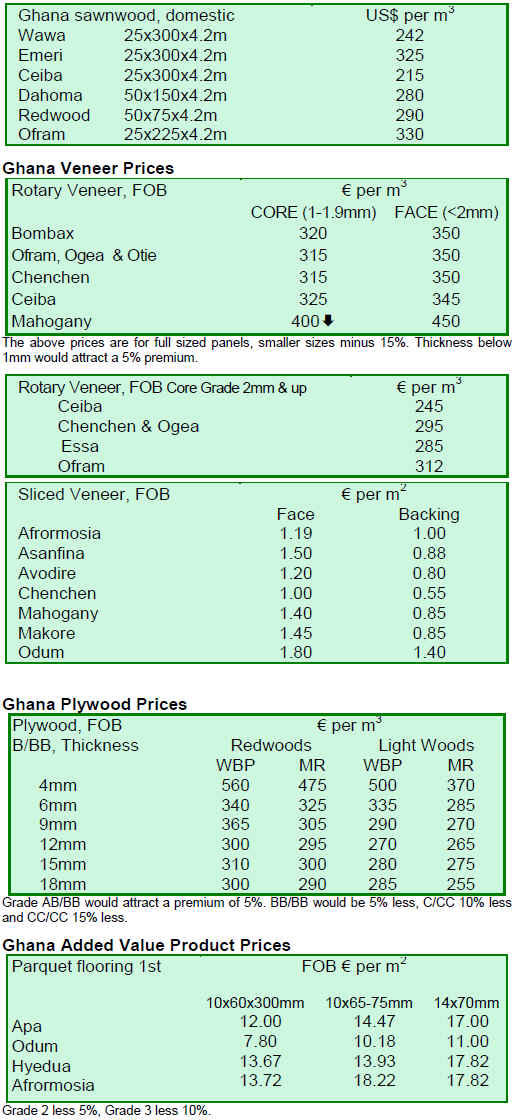
2.
SOUTHEAST ASIA
Plantations in Southeast Asia show dominance by oil palm
and rubber trees
Government officials in South East Asia have shown
strong commitment to plantation development mostly for
agricultural purposes. While there has been some
controversy over the growing of these species in Malaysia,
Indonesia and Myanmar, government and private sector
investment has continued to be focused on the
development of palm oil, rubber and acacia plantation
resources particularly in recent years.
MALAYSIA
Minister seeks to raise plantation productivity
The Malaysian Minister of Plantation Industries and
Commodities, Mr. Bernard Dompok, said Malaysia needs
to maximize major plantation crop yields. Oil palms,
rubber trees and cocoa trees accounting for the bulk of the
crops, which the Minister is seeking to raise yields without
expanding Malaysia¡¯s existing planted land area.
According to Bernama, he said the Ministry would
encourage ¡®better planting materials, good agricultural
practices (GAP) and enhanced research and development
(R&D)¡¯.
Currently, more than 70% of available agricultural land is
already planted with oil palms. The national crude palm
oil (CPO) yield stands at 4 tons per hectare annually.
However, some plantations are able to obtain a yield of 6
to 7 tons per ha. A study conducted by the Malaysian
standard organization, SIRIM Bhd, revealed that 2.65
million hectares of oil palm trees could yield up to 7
million tons of oil palm trunks and 26.2 million tons of oil
palm fronds annually. Oil palm fronds are a rich source of
fiber for the manufacture of MDF and other panel
products. The Minister continues to be hopeful that the
national CPO yield can be raised to 6 tons per hectare,
thus obviating the need to plant another 2 million hectares
of oil palms.
Rubber trees have historically been a popular plantation
species in Malaysia. The current yield of natural rubber
latex in Malaysia is 1.4 tons per hectare annually,
compared to Thailand, which has shown higher yields at
1.8 tons per hectare per annum. Currently, there are 1.24
million hectares of rubber trees in Malaysia. However, the
Malaysian Rubber Board (MRB) has launched the latest
high-yield clone, RRIM 3001, that could yield 2 tons of
natural rubber latex per hectare per year. The MRB is also
working on creating future rubber clones that could yield
at least 2.0 m³ of rubberwood per tree to meet the demands
of the Malaysian furniture industry.
For timber under the country¡¯s forest plantation
programme, the Ministry is looking to produce 75 million
m³ of timber by 2020 to meet the raw material
requirements of the Malaysian timber industry. Soft
commodities accounted for RM112.43 billion of the
country's exports in year 2008, or 17 % of Malaysia's total
exports.
INDONESIA
Report explores investments in plantations for raw
material supply to pulp and paper industry
Researchers recently analyzed and questioned the extent to
which Indonesian plantations are used in the Indonesian
pulp and paper industry. A working paper by Romain
Pirard (CERDI, France) and Christian Cossalter (CIFOR),
explored the resources of five major plantations across the
Indonesian island of Kalimantan, which are expected to
have a total standing volume of 1,013,707 m³ to 1,705,027
m³ of pulpwood in 2009 and 1,087,109 m³ to 2,063,189 m³
in 2010. The five plantations are associated with the
following companies: ITCI Hutani Manunggal; Surya
Hutani Jaya; Finnantara Intiga; Korintiga Hutani; and
Hutan Rindang Banua, which has remained a dormant
company. The following provides an overview of each
company¡¯s resources.
ITCI Hutani Manunggal¡¯s plantation consists mainly of
Acacia mangium. The concession also includes an
additional 3,000 hectares of sengon. At least 4,000
hectares of acacia planted are for the furniture market in
Surabaya. The yield of the concession is estimated at
about 80 air-dried tonnes (ADT) per hectare of pulpwood.
Surya Hutani Jaya was last known as a PT Arara Abadi
under the Sinar Mas group. Since 2004, the company has
harvested for 2,878 hectares of plantation harvested at an
average age of 6.7 years. The company had 49,000
hectares of very degraded natural forests in its concession
area. Acacia mangium was the main species planted and
Gmelina arborea was planted on a much smaller scale in
high pH soil areas.
For Finnantara Intiga, initially 157,000 hectares of a total
concession area of 299,000 hectares were not permitted to
be replanted or converted. Three species were planted by
the company for pulpwood. They are Acacia mangium,
(85% to 90% of the total area), Acacia crassicarpa and
Eucalyptus pellita.
The Korintiga Hutani nursery produced sufficient rooted
cuttings and seeds for a yearly planting programme of
7,000-8,000 hectares. Eucalypts may be planted on larger
areas in the future as their wood is considered better for
plywood and as mass production of clones seems to give
satisfactory results. However, Acacia mangium and
Eucalyptus pellita will remain the main species and are
harvested at an average age of seven years for pulpwood
production.
MYANMAR
Myanmar promotes plantation establishment
Plantations for commercial use, local supply, industrial use
and watershed management have been established in
Myanmar. Myanmar¡¯s Statistical Year Book (2007) shows
525,785 acres of plantations were established from 2000 to
2007. Plantation type, area composition and species
composition can be seen in the table below.
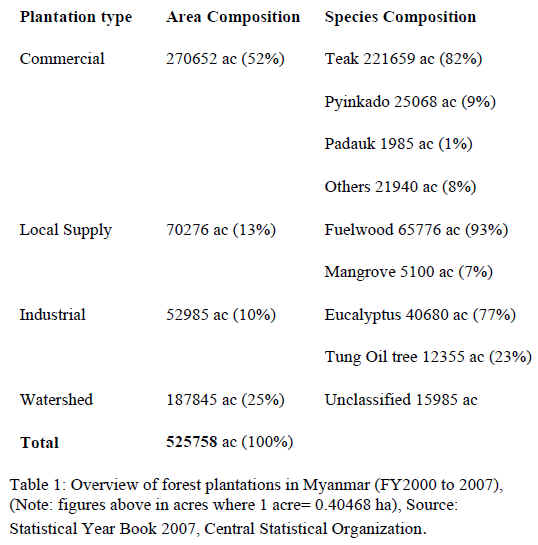
Plantations in Myanmar were established for various
objectives. Commercial plantations are mainly designated
for domestic timber supply and exports. Plantations
designated to supply the local market cover 70,276 acres
(28,440 ha) for fuel wood, posts and poles. Industrial typeplantations
of 52,985 acres (21,442 ha) are for paper mill
supply. Plantations for watershed management (catchment
protection) cover 187,845 acres (53,356 ha) to prevent
erosion. Teak accounts for the largest plantation area of
221,659 acres (89,702 ha). The objective of these
plantations is to help increase production while reducing
pressure on natural forests.
Establishing systematic teak plantations began in 1856
using the Taungya method, an afforestation method where
crops are interspersed with trees on cleared land.
However, the extent of plantations at that time was very
limited to small scale compensatory plantings to enrich
and supplement the growing stock. The post-World War II
population boom resulted in an increased use of timber
products. Changes in land-use patterns and the
deterioration of natural forests further exacerbated
pressure on forests. To address the situation, plantations
were established to expand the modest compensatory
plantings into large scale block plantations since 1962.
From 1896, plantation establishments were systematically
organized by the Forest Department (FD). Since 1984, FD
had been establishing 30,000 hectares of plantations
annually. The total teak plantation area from 1896 to 2007
was 384,123 hectares. Other species planted during the
same period were: pyinkado (61,899 hectares); padauk
(17,426 hectares); pine (21,685 hectares); and others
(421,376 hectares). The teak plantation area is about 18%
of the global teak plantation resources.
It is not clear how much plantation timber has been
harvested and traded in Myanmar. Most people from the
timber trade tend to connect plantations with natural
forests. This perception is due to the observation that teak
and other valuable species are planted to compensate for
the natural forests. Sales of poles and posts are the only
way to trace teak from plantations in the timber trade. In
other cases, it is necessary to devise a statistical system by
respective departments to differentiate which trees are
from plantations and which are from natural forests.
The Ministry of Forestry formulated a Special Teak
Plantation Programme (STPP) in 1988, designed to
establish 8,100 hectares of plantations every year for 40
years, with a view to creating 324,000 hectares of teak
plantations. The Forest Department estimated that, after
the year 2038, annual sustainable teak production could be
as high as 1.8 million m³.
In the past, establishment of teak plantations and
harvesting of teak has been conducted solely by the State.
According to Myanmar Forest Law of 1992, ¡®A standing
teak tree wherever situated in the State is owned by the
State¡¯. However, in 2005, the Myanmar government
granted permission to local investors to establish teak
plantations. This has been a great opportunity for local
entrepreneurs. Under this scheme, the government leases
forest land to local investors to plant teak. The investment
returns from teak plantations are shared between the
government and the investor on a 20:80 basis. Increasing
demand for teakwood, coupled with technical advances in
processing led to greater participation from the private
sector in establishing plantations. It is reported that many
private investors are now involved in plantation
investment in Myanmar.
There are also a number of challenges facing investors in
the country. Long-term investments require proper
planning, appropriate agro-forestry practices mixed with
short-term tree planting. To combat illegal activities, law
enforcement, patrolling and income generation in the
community is required. To reduce the monoculture effect,
a buffer zone in the plantation area needs to be established
and mixed species need to be planted. It is suggested that
investors should proceed with caution before investing in
teak plantations, as improvement of teak quality and
maintenance and further research on utilization of small
diameter logs is required.
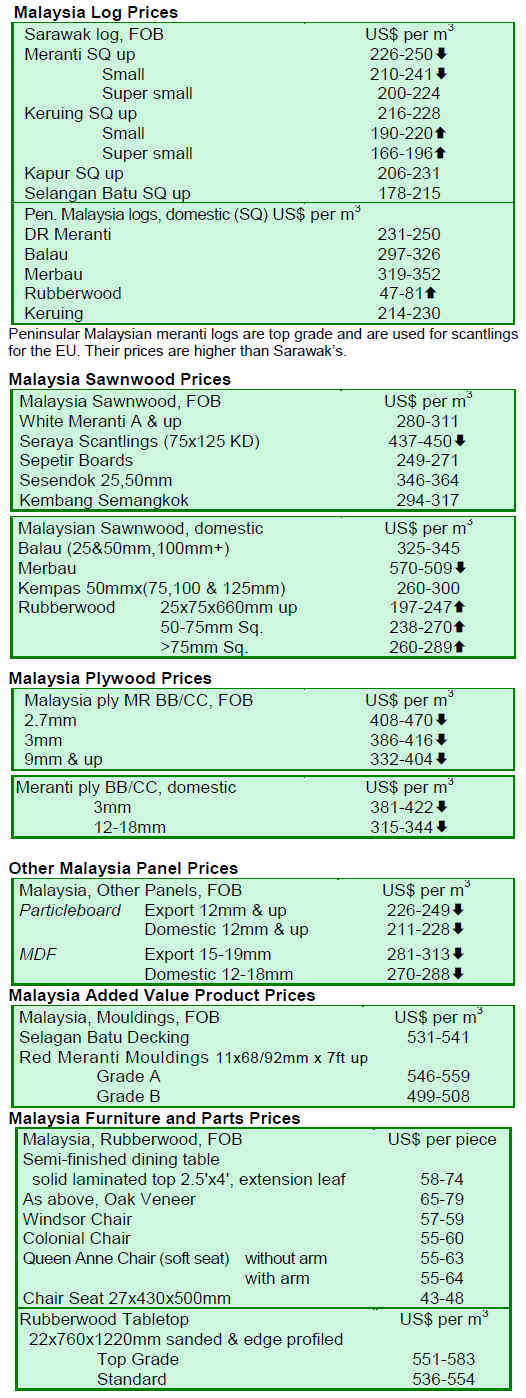
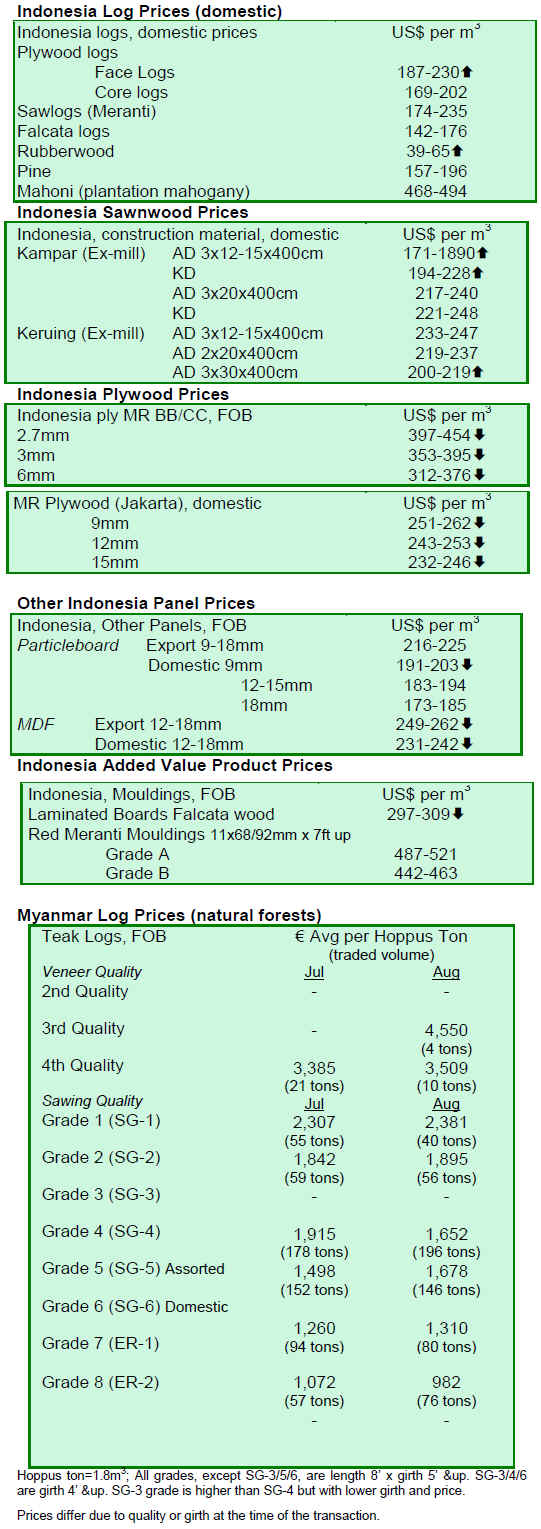

3.
SOUTH
ASIA
INDIA
Plantation areas expand in India
During the ¡®Van Mahotsav Festival¡¯ or ¡®Festival of
Forests¡¯, a large number of trees are planted in every state
of the country. The forest department also helps local
communities and village-level panchayats to plant millions
of saplings, which are mostly distributed free of cost. For
planting in urban areas, the saplings are distributed at
nominal charge of about Rp. 1 per sapling (TTMR 13:15).
In conjunction with the event, the Karnataka Forest
Department decided to promote sandalwood cultivation in
the district of Chitradurg by distributing 50,000 saplings of
sandalwood. This was achieved as a result of an
amendment to the Karnataka Forest Rules of 1969,
enabling certain norms relating to sandalwood cultivation
by private parties to be changed. Previously, those
cultivating sandalwood saplings had to sell harvested trees
only to the state forest department, thus reducing the
incentive for people to cultivate sandalwood. The
amendment allows the sale of sandalwood directly to
semi-government agencies, making it much easier and
faster to sell products in the market. To avoid smuggling
and illegal trade, the department is involved in the sale of
the wood and keeps records of timber sold. The
government is generating incentives for farmers to
cultivate this species by offering a 75% subsidy to
establish these plantations. Similar programmes are being
carried out in other districts of Karnataka.
The establishment of plantations in India has had a mixed
history. In 1956, the price of sandalwood was Rs.6 per kilo
compared to the current value of up to Rs.6000+ per kilo.
Based on the guidelines of the present government¡¯s
import-export policy, sandalwood logs can only be
imported under license. This is a big deterrent for
sandalwood-based factories from getting raw materials
and for thousands of handicraft workers who depend on
income from sandalwood carvings. The present restriction
on imports of this timber has created scarcity of raw
material for the artisans. This shortage also encourages
smuggling of sandalwood trees from government as well
as private entities. All timber imports in India with the
exception of sandalwood are under the Open General
License (OGL), meaning these are sold without tax.
Imports of sandalwood logs could be stimulated if these
could be designated as eligible for OGL to bring down
prices and stop illegal smuggling of the species. Given the
current shortage of raw materials (if corrective measures
are not taken), many experts believe the handicraft
business will vanish.
One socio-religious institution, BAPS, has taken a bold
decision to plant 100,000 saplings of Santalum album in
the land attached to their temples and have already made
strides to undertake planting activities. In India, temples
have a large use for sandalwood and the newly planted
trees are expected to help meet these needs. Captive
plantations by companies manufacturing mouth freshener
¨C pan masalas ¨Chave also been established in Madhya
Pradesh in and around Katni where over 200,000 saplings
have been planted.
Santalum album has been planted in North Gujarat around
Mehsana, South Gujarat around Valsad and in coastal
areas of South Saurashtra. These areas are not natural
areas for sandalwood. Experimental plantings are under
study, although some eucalypt plantations in experimental
areas have already shown success in the State of Gujarat.
The state government and its Forest Department are fully
supportive of encouraging plantations to boost local
incomes, supply raw materials to wood working units and
provide poles to the building industry.
On the contribution of plantations to combating climate
change, DNA India says that the State of Haryana is
committed to combat climate change and ¡®green¡¯ Haryana.
The Chief Minister has announced a policy to promote
forest cover in the state. The present tree cover in Haryana
is 7.13%, and is envisaged to increase to 10% by 2010 and
20% by 2020. Apart from government efforts, other
private entities are also establishing plantations of
eucalypt, poplar and acacia to supply raw materials. Those
establishing plantations also receive assistance and the
state government has pre-identified 800 villages in the
state for afforestation and poverty alleviation activities.
Innovative initiatives in agro-forestry have been
introduced for the benefit of small and marginal farmers
while augmenting the supply of raw materials to the woodbased
industries in the state.
Similarly, companies in other states also keep establishing
timber plantations to meet their requirements for raw
materials. ITC Ltd has by now almost 100,000 hectares of
eucalypts, casuarinas and subabul in Andhra Pradesh for
making paper pulp. Mangalam Timber Ltd, an old player
in MDF manufacturing has initiated forestry activities as
early as 2001 and has now some 50,000 acres under
eucalypts in Orissa, Chhatisgarh and Andhra Pradesh. The
emphasis is to be independent and to ensure steady supply
of logs for MDF production. Many businesses are
establishing plantations in order to be self sufficient in
their raw material supply and to stimulate measures to
combat climate change.
Reliance Industries also have approximately 7,500 acres of
mango and teak plantations to improve the environment
around their refineries near Jamnagar. Plywood factories
in Haryana and Uttaranchal draw most of their
requirements from poplar and eucalypt agro-forestry
crops. A particleboard manufacturing plant of 300,000 m³
per year capacity is being established by the Associate
Lumber group owned by the Agicha and Darvesh families
in the State of Karnataka. The group is also planning to
establish 25,000 hectares of plantations to meet their raw
material requirements.
There have been many tree planting activities along
canals, railway tracks, highways and the harvest from
these plantings have significantly augmented timber
supplies in the country. The antique furniture reproduction
units in Rajasthan are getting most of their supplies from
Canal bank Sissoo (Dalbergia sissoo) plants. Acacia
mangium and Melia dubia plantations in Kerala and
Karnataka are providing good timber for doors, windows
and building joinery components. Bamboo and eucalyptus
are meant for the paper and rayon pulp industry. Kerala
has the largest share of teak plantations. Maharashtra,
Madhya Pradesh, Gujarat Orissa and other states also keep
expanding teak plantations and the harvested logs are sent
to government forest depots for auction.
Since India has yet to reach its forest cover of 33% of the
land area, state governments do not cut trees in natural
forests. India¡¯s demand for teak is much more than what is
available presently - it permits imports of teak and other
timber freely without any license or permit requirements.
Below are countries which export teak to India (from
sources other than Myanmar) at current C&F prices for
Indian ports.
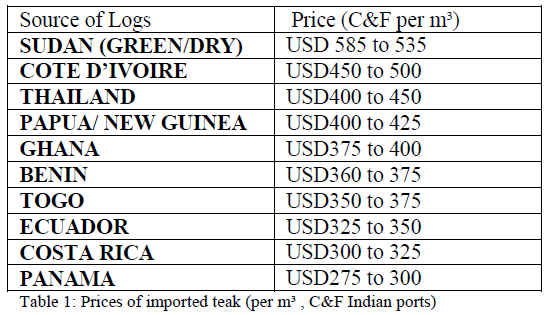
Measurement systems for plantation teak are different,
depending on the exporting country. Some countries allow
a 10 cm deduction in girth to compensate for bark and
sapwood, while others allow 6 cm or only 2 cm.
Therefore, if the importers are not well versed in the
matter, they suffer. Teaknet plans to take up the matter of
uniform specifications, measurement systems and
allowances for sapwood and bark and some guidelines on
uniform price vis-¨¤-vis classifications. The local practice
in India is for the logs to be measured under the sap,
whether it is teak or another timber. To protect buyers and
consumers, the ideal system would be to measure logs
under the sap so allowances for sapwood and bark will not
arise. It is hoped that Teaknet will take up this matter in
due course, possibly at the international seminar planned
by them during the month of November 2009 (see TTMR
14:13).

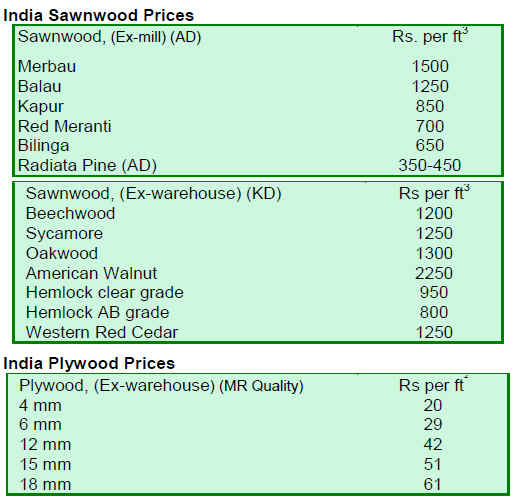
4.
LATIN
AMERICA AND THE CARIBBEAN
Brazil benefits from greatest investor interest in
plantations
Much investment in plantations has been centered on Latin
America, given its attractive investment environment.
Brazil, Peru, Mexico and Guyana have all experienced
growth in their plantation areas in the last few years. In
particular, institutional and individual investors are drawn
to Brazil, as it has shown promise in generating attractive
returns for investors¡¯ portfolios.
BRAZIL
Eucalypts and pine dominate plantations in Brazil
Forest plantations play a fundamental role in the socioeconomic
development of the country, contributing to the
production of goods and services, adding value to forest
products and generating jobs, foreign exchange, taxes, and
income. Yet, it is estimated that forest plantations account
for about only 1.5% of the existing forests in Brazil,
although they play a major role in forest products markets
accounting for an estimated 70% of the total industrial
roundwood production.
Total plantations in the country are estimated at 6,582,700
hectares in 2008, about 93% of which comprises eucalypt
and pines, with the remaining 7% from other species
(notably wattle, rubber tree, paric¨¢, teak, Parana pine and
poplar).
The main planted species in Brazil are mainly investments
for profit; afforestation and reforestation programmes of
forest companies are geared to supply industrial
roundwood for the well-established and diversified forest
products industry of the country (e.g., pulp and paper, pine
lumber/sawnwood, reconstituted wood panels, pig-iron
and steel industry, and energy wood).
Such plantations are oriented to supply the industrial
roundwood needs in the country, for both the domestic and
export markets. The high productivity of plantations,
relatively low production costs, extensive land area and
advanced technology in Brazil gives the country
comparative and competitive advantages in establishing
plantation forests, making it an important producer of fastgrowing
plantation forest products.
While plantation sites set aside for pine and eucalypts
range from those in degraded areas to those for agriculture
purposes, the plantations are generally geared for
production of industrial roundwood. It is worth
mentioning that the growing importance of partnership
forest plantation programmes between large corporations
and small to medium-size landowners in the last few
years.
Forest plantations with eucalypts and pine were estimated
at 6,126,000 hectares in 2008. Eucalypts accounted for
4,259,000 hectares, while pines accounted for 1,867,000
hectares. Graph 1 below shows the distribution of eucalypt
and pine planted forest in the main Brazilian states.
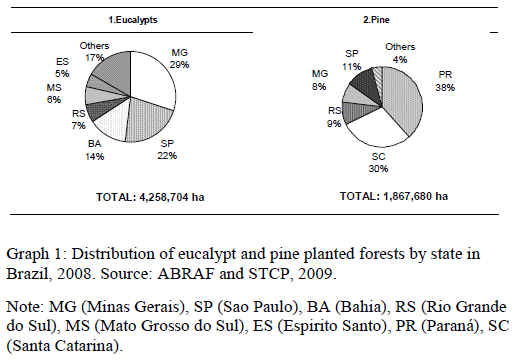
A total of 1,439,276 ha of planted pines in Brazil in 2008
(77%) are concentrated in the South (states of RS, SC and
PR). The Southeast region comprises 56% of eucalypt
planted area in the country (ES, SP and MG). Minas
Gerais has the largest combined eucalypt and pine planted
area in Brazil (1,423,212 ha), followed by São Paulo
(1,142,199 ha).
The largest Brazilian companies establishing forest
plantations are associated to the ABRAF (Brazilian
Association of Forest Plantation Producers). These
companies together account for 55% of the total planted
area in the country. As for planted forests by industrial
segment among ABRAF members, the largest area
belongs to companies in the pulp and paper segment (76%
pine and 70% eucalypt). As for pine, the segments of
reconstituted panels and iron and steel industry
concentrate, respectively, account for 15% and 9% of the
planted area. On the other hand, for eucalypts, 21% of the
area belongs to the iron and steel industry, and 6% to
reconstituted panel companies among ABRAF members.
Most companies of the forest sector were affected by the
global economic crisis since the last quarter of 2008. As
future investments in the planted forest sector depend on
the recovery of the economy, investments in forest
plantations for the next few years are expected to be
reduced with planting in 2009 being possibly the most
affected.
Although eucalypts and pine are the dominant planted
species in Brazil, other species such as acacia/wattle,
rubber trees, paric¨¢ and teak account for a significant part
of the so-called other species. They also deserve attention
due to their economic importance and recent expansion of
their plantation area. Table 1 presents forest plantations
areas and relevant aspects of other species planted in
Brazil.
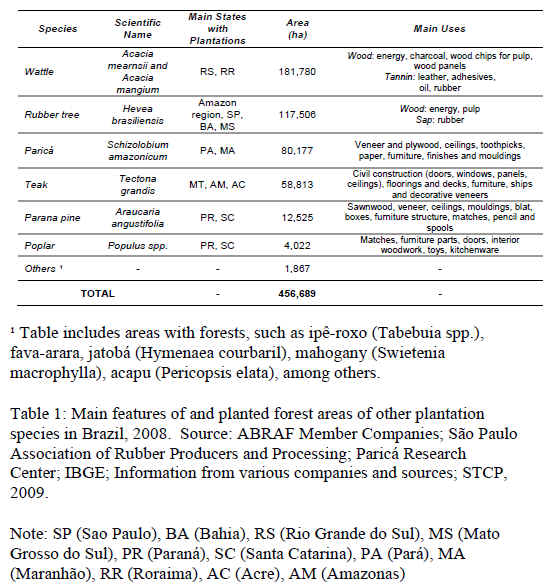
Acacia/Wattle plantations in Brazil (Acacia mearnsii and
Acacia mangium) are concentrated in Rio Grande do Sul
(South) and Roraima (North). In Rio Grande do Sul, A.
mearnsii (black wattle) is cultivated by thousands of small
forest producers, which supply companies of the tannin
segment (extracted from acacia bark). Acacia production
is designed to meet both foreign and domestic demand,
with consequent job and income generation in Brazil.
Black wattle wood is used as fuelwood, for charcoal
production and exported as wood chips for pulp, mainly to
Japan. The tannin destined for the domestic market and
supplies the tannery, adhesives, oil, and rubber sectors,
among others. In addition, part of Brazil¡¯s tannin
production is exported to over 50 countries.
The rubber tree (Hevea brasiliensis) is cultivated for
rubber latex tapping for the production of natural rubber,
while the rubber wood can be used for fuelwood or for
furniture production. The species is originally found in the
Brazilian Amazon, but is planted in Northern states. Minas
Gerais has natural conditions (soil, climate, topography
and water availability) and favorable geographical
locations to expand rubber tree plantations on a large-scale
for agribusiness activities, according to EPAMIG
(Agricultural and Livestock Research Institute of Minas
Gerais). Thus, it is expected that rubber tree plantations
would increase steadily in the state. Such competitive
advantage has been explored for many years by states such
as São Paulo, Mato Grosso, Bahia and Mato Grosso do
Sul. EPAMIG (Corporation for Agricultural and Livestock
Research of Minas Gerais) has undertaken studies based
on the Brazilian strategy to avoid dependence on imported
natural rubber, used as a raw material for various products.
Paric¨¢ (Schizolobium amazonicum) plantations are
concentrated in the Northern states of Par¨¢ and Maranhão.
This species is native to the Brazilian Amazon and is
suitable for manufacturing veneer, plywood, ceiling,
toothpicks, furniture, wood finishing, and mouldings.
Teak (Tectona grandis) plantations in Brazil are located
mainly in Mato Grosso, Amazonas and Acre. It is
considered one of the most valued timbers in the
international market, which is the reason for its expansion
in plantation areas in recent years. Its main uses are for
civil construction (doors, windows, panels, ceilings, etc.),
flooring and decks, furniture, shipbuilding (roofs, flooring,
ceilings), decorative veneer, decoration and ornaments in
general (sculpture and woodcarving). Teak was planted
about 25-30 years ago in Brazil (with an area by that time
quite small compared to the total current plantation of
nearly 60,000 hectares ¨C mainly in Mato Grosso). Thus,
most plantations are still at a young age (not yet
managed/thinned). Plantations are concentrated among 10
major companies and only few of them have mature
forests producing high-value timber products for export.
The remaining companies are about to start managing their
young plantations (thinning at a low age of 8) and will
therefore be producing small-diameter logs for low-end
domestic product markets (fuelwood/residues).
Parana Pine/Araucaria (Araucaria angustifolia) forest
plantations are located mainly in the Southern states of
Paran¨¢ and Santa Catarina. The main wood utilization is
for sawnwood and veneer, solid wood products, such as
ceilings and mouldings, furniture, long-fiber pulp, among
others. Despite its importance for certain regions,
araucaria planted area in Brazil decreased over the last few
years. This is mainly due to its substitution by other fastgrowing
species and laws restricting araucaria logging
(including natural and planted forest). In addition, the
IBAMA Administrative Ordinance (Instrução Normativa)
06/08 lists araucaria as a threatened native species;
therefore, it is subject to legal restrictions on its
harvesting, for any purposes, which can be done through a
permit obtained from the competent environmental
agency.
Poplar (Populus spp) forest plantations are also
concentrated in Parana and Santa Catarina. This is a minor
planted species, generally used in manufacturing of
matches, furniture parts, doors, interior woodwork, and
others.
Investors diversify portfolios with Brazilian plantations
Brazil has attracted significant direct investments in recent
years. Such investments are a result of from the high
competitiveness reached by the country in plantation
forests. Brazil has integrated its competitive advantages in
the forest sector through favorable natural conditions,
scientific knowledge and entrepreneurial capacity, which
results in a highly competitive potential growth.
Brazil ranks first in the Inter-American Development Bank
(IDB) Forest Investment Attractiveness Index (IAIF) for
the Americas. Such index measures the attractiveness of
the forest sector of Latin American & the Caribbean
(LAC) countries for direct investment to guide investors in
selecting countries with high potential for successful
investments in the forest sector. Brazil leads with a score
of 60 out of 100. It is followed by Chile, Uruguay and
Argentina. Investors associated with forest investment
have established and acquired forest assets, pointing to a
continuous growth of Brazilian forest plantations.
The instruments with high growth in the country are
investment funds in forest assets for pension funds and
forest funds specifically established for this purpose.
These funds have different sources, including domestic
and foreign capital, and many other funds are still in the
process of development, and are geared primarily to the
establishment of fast-growing forests (planted forests) not
necessarily linked to industrial projects.
Investment funds can be managed by TIMOs (Timberland
Investment Management Organizations) or by companies
specialized in forest management. TIMOs have been a
way of organizing successful investors in Brazil, mainly in
the Southern region, with planted pine forests. In some
cases, TIMOs themselves have capital for investment in
forests. Despite the global economic crisis, experts suggest
TIMOs work will increase in Brazil in the coming years.
To purchase forests in Brazil and elsewhere, investment
funds concentrate mostly on the acquisition of mature
forests, which may include afforestation, buyback
guarantee for timber, price setting and other mechanisms.
However, there are variations in investment types and
forms. In Brazil, due to the limited availability of forest
assets, investment funds have been more diversified, with
some focusing on niche markets of less value-added
products such as pulpwood and charcoal.
Brazil has great competitive advantages for production
forests compared to other countries such as high
productivity in species such as eucalyptus (average of 35
m³ of wood/ha) and short rotation cycles of 6-7 years for a
first harvesting. The volume of CO2 sequestered by a
forest depends on the species planted, clone type, soil and
climate conditions, forest management and others. It is
estimated that a eucalypt forest with such average
productivity contributes to the sequestration of
approximately 200 ton of CO2 equivalent per hectare per
year.
As an alternative to the scenario set by the Clean
Development Mechanism (CDM) under the Kyoto
Protocol, Brazilian forestry companies concentrated their
efforts on climate change for the Chicago Climate
Exchange, where more flexible rules allowed carbon credit
generation and trading for forest projects in eligible under
the current CDM rules. As a new undertaking, a number of
companies have studied opportunities for the
establishment of afforestation/reforestation and REDD
projects associated with the carbon credit markets. Such
projects are yet to be developed in the country.
Future outlook for plantation species in Brazil
In 2008, Brazil was upgraded from speculative grade to
investment grade in the credit ratings index of Standard &
Poors, which allows a country to capture external capital
resources at lower interest rates (low risk premium of debt
securities).
Besides this rating, Brazil offers attractive factors for
foreign investors, including the possibility of access to a
broad and growing consumer market and greater political
stability. Given the current international economic crisis, a
shortage of external credit and low investment, Brazil has
become an alternative to business groups that have greater
liquidity and are ready to invest. The comparative and
competitive advantages of the country in the forest sector,
especially with fast-growing plantations, almost
guarantees high returns to investors.
In Brazil, the forest sector has developed mainly based on
domestic direct investments. However, foreign direct
investments flows have also increased in recent years. In
the short-term, the global financial crisis may only delay
the previously announced investment plans in the forest
sector; on the other hand, in the medium and long-term,
the implementation of mega-investments is expected in
planted forests and the forest-based industry. This
perspective promises to increase production, in both
forests and industrial processing, to levels never
experienced in the past.
Investments in planted forests in traditional forest
plantation states and in new forest frontiers represent a
new phase of the planted forest sector¡¯s growth, to
generate jobs and income, product diversification, social
inclusion, and foreign exchange earnings for the states
benefited with large-scale forest plantations.
The investment prospects (2009/2012) for the pulp and
paper industry, based on a BNDES survey carried out in
August 2008, was around BRL26.7 billion. This estimate
has been reduced drastically to BRL9.0 billion in
December 2008. This shows a significant decrease of 66%
in the investment prospects of the Brazilian pulp and paper
industry. According to the BNDES study, this reevaluation
is due to the lack of confirmation of
investments and postponements of projects rather than
cancellation.
The forest sector (mostly the plantation sector) currently
generates more than 700 thousand direct jobs in Brazil.
STCP consulting estimates that in 2030, the sector will be
able to generate 1.6 million direct jobs, with one-third in
the silviculture (plantation) area. This estimate shows the
sector will be among the three biggest job generators in
Brazil in the coming decades.
Recent estimates for the next decade have recognized the
need to expand forest plantations from the current 6-7
million hectares to nearly 20 million hectares by the year
2050. This is to supply the growing demand for industrial
roundwood of the highly-diversified and expanding forest
products industry in the country and new direct
investments expected by domestic and foreign investors.
PERU
Forest plantations in Peru show potential for growth
In Peru, the government invests a small amount of funds to
implement reforestation or afforestation projects for
industrial or commercial purposes. The reforested land for
commercial purposes has been established by means of
private investment. Experts note that little investment
exists from the Peruvian government, even though
products consumed by Peruvians are derived from wood
from neighboring countries. They have indicated a number
of problems with plantation forests in Peru including lack
of finance and capacity, weak institutions and
underdeveloped markets for products. Technological
innovation has not spread to the forest sector and many
regions continue working with outdated technologies to
harvest and process wood.
Nevertheless, according to the INRENA, there exists a
great potential to develop plantation areas. The Fund to
Promote Forest Development (Fondebosque), a
government institution, is using two mechanisms to
finance diverse projects in the Peruvian Amazon. The first
mechanism is a fund that has finances business plans up to
USD18,000 for machinery, equipment and tools through a
short-term bank credit. The beneficiary uses the machinery
and later pays back the credit in monthly installments. A
second mechanism involves partial grant by
FONDEBOSQUE and partial contribution from the
beneficiary. It provides finance for associations,
cooperatives and producers¡¯ networks up to USD65,000
for civil works, machinery, equipment, tools, inputs and
training activities. Sound business plans are required to
access both funds to demonstrate the technical, economic,
environmental and social viability of the plan.
A number of geographical areas in Peru also have a great
potential to be developed with plantations. In particular,
the following are areas where plantations could be
established: the Department of Pasco in Oxapampa; the
Department of Junin in the Valley of the Mantaro, Satipo;
the Department of San Martin in Tocahe, Tarapoto; the
Department of Ucayali in Coronel Portillo; and the
Department of Huanuco in the Code of the Pozuzo. The
table below shows the type of plantation species that can
be planted in Peru by regional ecosystem:
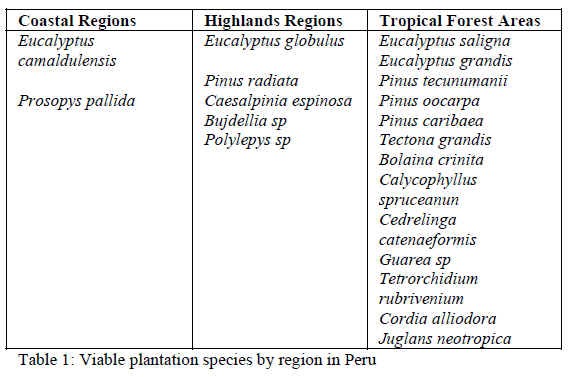
MEXICO
PRODEPLAN sets pace for forest plantation development
The programme for the development of commercial forest
plantations (PRODEPLAN) will be implemented in 32
states of the country and given special attention to targeted
populations. The beneficiaries of the programme can be
individuals or entities and are selected by a committee
following the terms and conditions established in the
Rules of Operation and Assembly, which are issued by the
National Forest Agency CONAFOR. As part of the
development of commercial plantation programmes,
ProTree also has different programmes for this purpose,
which include the programme for the establishment and
maintenance of commercial forest plantations. As part of
the programme, the following plantations will be
established: non-timber plantations of both arid and
tropical species; plantations of Jatropha curcas; agroforestry
plantations with timber species; and Christmas
tree plantations.
The government is also granting financial support for the
management, technical assistance and insurance of
commercial forest plantations. The federal budget for
supporting such programmes amounts to a total of
531,697,791 Mexican pesos. Of the total, 88% is dedicated
to support the establishment and maintenance of
commercial forest plantations, which is up 2.5% this year
for operating expenses and project evaluation and nearly
10% for project supervision. The maximum amount of
support to be granted for the establishment and
maintenance of commercial forest plantations and
developing management programs will depend on the
maximum limits for each type of plantation included in the
Rules of Operation.
To have access to ProTree resources, individuals should be
Mexican nationals or entities incorporated under Mexican
law to participate in the general selection procedure. The
Rules of Operation for Commercial Forest Plantations
state that eligible parties: are owners or holders of land,
preferably of forest or temporary forest land; should
provide a description of projects, preferably for forest land
or temporary forest land; submit their applications and
respective proposals in line within the appropriate
deadlines, terms and conditions established in the
Assembly and in accordance with these Rules; are not
subject to any other support or subsidy from the Federal
Government such as replacement from or overlap with the
ProTree program in this category, based on the opinion
given by the General Coordinator of Production and
Productivity of CONAFOR.
Domestic and foreign companies established under
Mexican law have excellent investment prospects from
commercial plantations in the country. Mexico has 11
million hectares dedicated to forestry activities, although
the area also has some agricultural uses with lowproduction
farms. With further capacity building, private
investment and federal support, it is anticipated that
sustainable and productive commercial forest plantations
can be developed.
Investment returns for commercial forest plantations in
Mexico is less than in other countries in the region.
Nevertheless, there is a diverse set of ecosystems in
Mexico where: a number of trees are being planted in
temperate, cold and warm/wet climates; access to land is
relatively simple and there is infrastructure available; they
are also strategically located in relation to high
consumption areas - North America, the Pacific Rim and
Europe. Moreover, the federal government provides
economic support incentives in forest plantations, in
addition the average rate of return on investment or
Internal Rate of Return (IRR) obtained in Mexico is higher
than that achieved in similar projects in other countries.
Domestic or foreign investors can invest in new projects,
from the beginning or engage in projects that have already
commenced, and in some cases beyond the stage next to
pre production. To become involved in an on-going
project, experts suggest establishing a relationship with a
Mexican company or joint venture (domestic and foreign),
which already has plantations but requires an injection of
capital to expand its planted area. There are also a large
number of afforestation or commercial forest plantations
that are in a pre-productive phase and require partners with
new financial resources even though they already have
financial support from the federal government.
A second strategy is to start a new plantation project
through a subsidiary company, incorporated under
Mexican law, which could directly be involved in
operational activities such as feasibility studies for
projects, assessments of locations for new projects,
selection of plantation species, programme management
and presentations to SEMARNAT, plantation
establishment and protection and management of
plantations.
The investor that is engaged in a joint venture with a
Mexican company or prefers starting on his/her own can
access the support offered by the Mexican government. It
is noteworthy that, whether or not he is beneficiary of
federal funding, any investor in Mexico has the legal
protection of the Mexican law, as long as the contracts
associated with the rental, purchase, rural partnership or
joint venture for the project are registered with the
Secretary of Agrarian Reform. If foreign investors engage
in commercial forest plantation projects, they must comply
with Mexico¡¯s Foreign Investment Law.
For more information on plantation investment in Mexico,
contact Carmelo Hermandez, Manager for Development of
Commercial Plantations at 52-33-37-77-70-00 Ext. 2200
to 2223 or Toll Free 1-800-50-59-888 or email
chernandezp@conafor.gob.mx.
GUYANA
Plantations have long history in Guyana
After the Second World War, colonizers set up a number
of pilot plantations as permanent research plots to
investigate the growth rate of Pinus Caribaea under
different treatments ¨C soil types, pruning and fertilizer.
Pinus Caribaea were planted at Bartica from 1955-1965
and Ebini from 1964-1968.
Steadily rising prices for lumber coupled with more
recognition of the (non-timber) values of natural forests
seem destined to drive forest enterprises into the
establishment of plantations. The Guyana Forestry
Commission (GFC) has demonstrated in the past that
exotic species such as teak (Tectona grandis) and
Caribbean pine (Pinus spp.) can grow commercially in
Guyana. It has been observed too that various local species
such as tauroniro (Humiria balsamifera), and simarupa
(Quassia simarouba) have potential as plantation species
because they require a high amount of light and grow well
on poor sandy soils.
There are many areas in Guyana which could benefit from
plantations, especially the large expanses of savannah
lands located in the hinterland areas of Guyana.
Communities can certainly benefit economically from
managing nurseries and producing seedlings for sale to
persons engaged in setting up plantations. Nursery
practices (and seed technology) could also provide
employment for women and the aged.
Silvicultural projects based on plantations carry two major
challenges. The first is to choose the right species (light
demanding, fast growing, robust in the face of poor soils,
pests and water scarcity). The second challenge is the cost
of inputs and tending activities, once the trees start to
grow.
The revised Forest Act also recognizes the value that
plantation forests can bring to Guyana by encouraging the
establishment of same. The GFC and other institutions,
such as the University of Guyana, and the Guyana
Geology and Mines Commission have already initiated
discussions on promoting this as an activity.

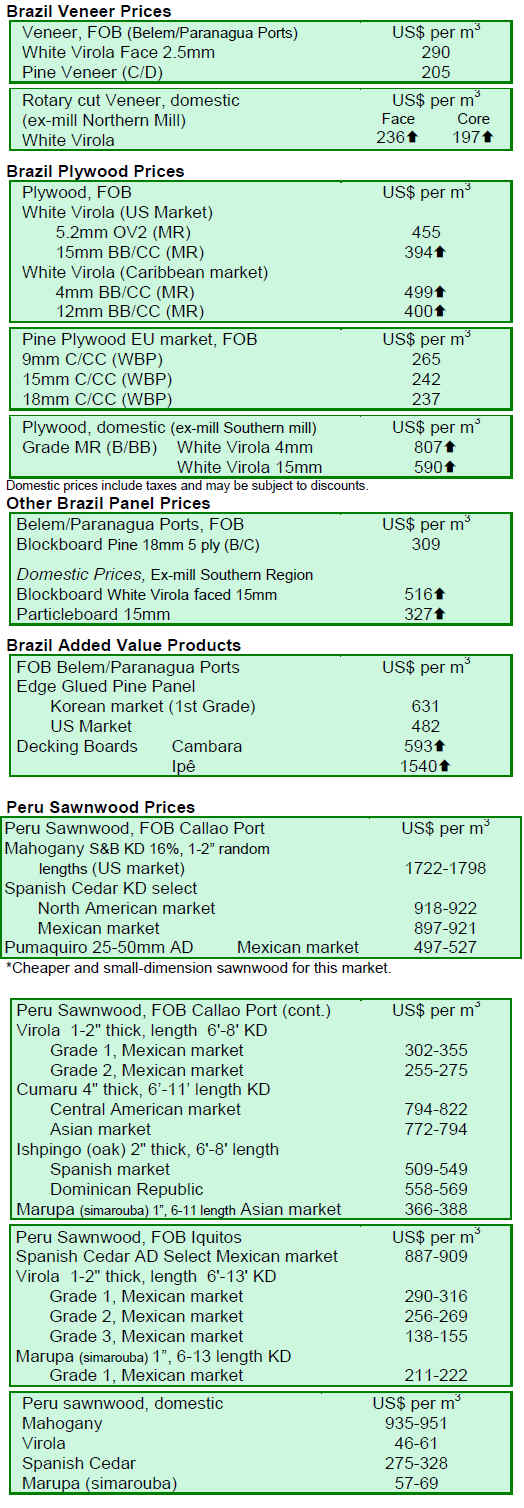
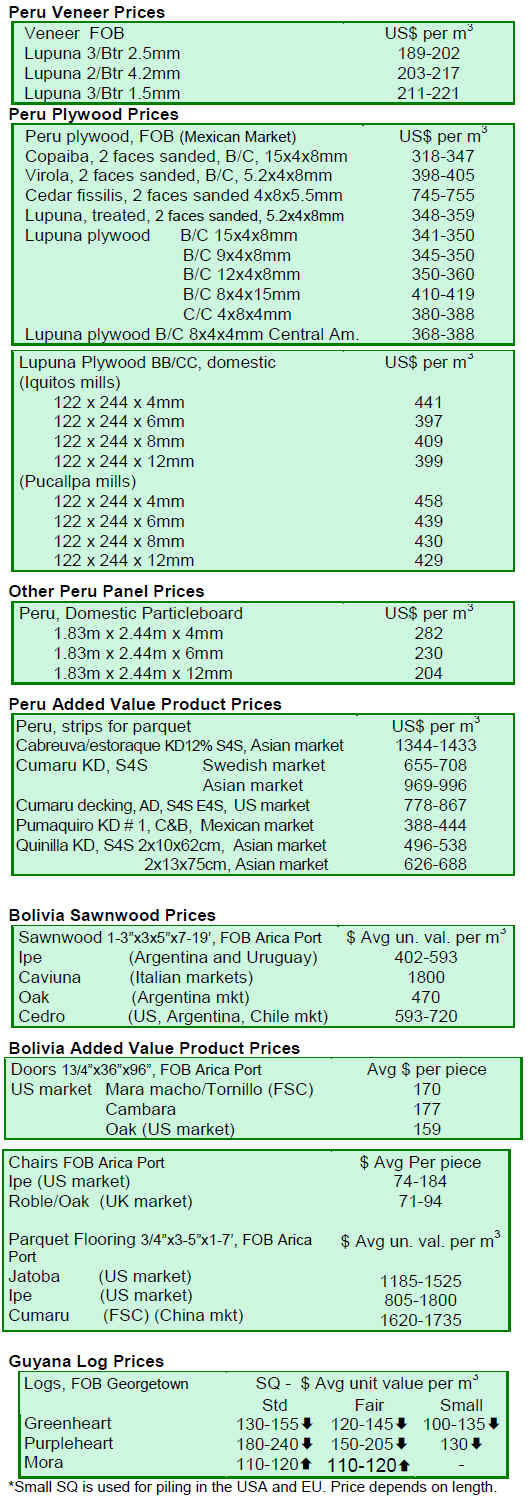
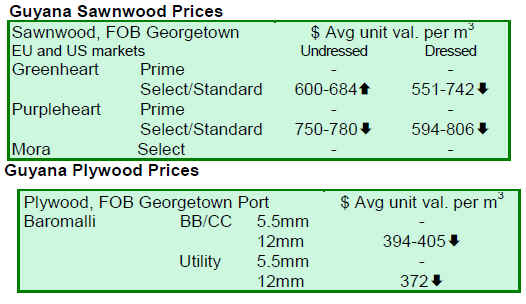
|